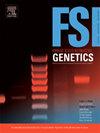A continuous model for interpreting microhaplotype profiles of forensic DNA mixtures
IF 3.1
2区 医学
Q2 GENETICS & HEREDITY
引用次数: 0
Abstract
Microhaplotypes (MHs) have great potential in forensic DNA analysis, with applications in individual identification, kinship analysis and ancestry inference. No matter the forensic application, the analysis of DNA mixtures may be encountered. This study aims to develop and evaluate a continuous model for interpreting mixed genotype data from MH markers. We characterized MH profile features and modeled allele read counts using a truncated Gaussian distribution, accounting for allele dropout, noise, and locus-specific detection efficiency. The model was tested on 90 DNA mixtures generated from nine unrelated individuals across various mixture proportions. Likelihood ratio (LR) values were computed for both true contributors and non-contributors, and mixture deconvolution was performed. Results demonstrated high accuracy and specificity in interpreting MH profiles for 2- to 3-person DNA mixtures: true contributors obtained LR values greater than 1 in 190 out of 200 LR calculations. In 26,700 simulated non-contributor tests, for 2-person mixtures, the proportion of non-contributors with an LR greater than 1 was 0.0051 %; for 3-person mixtures, this proportion was 4.68 %. Excluding balanced individuals in mixtures, the average deconvolution accuracy rate for major contributors was 0.9145, with 60.98 % (100/164) achieving an accuracy rate of 1. Additionally, we observed that distinguishing alleles from non-alleles became increasingly challenging with higher mixture proportions or additional contributors, with noise identified as a critical factor affecting genotyping accuracy.
用于解释法医DNA混合物微单倍型谱的连续模型
微单倍型(Microhaplotypes, mh)在法医DNA分析中具有巨大的应用潜力,可用于个体鉴定、亲属关系分析和祖先推断。无论法医应用,DNA混合物的分析可能会遇到。本研究旨在开发和评估一种连续模型,用于解释MH标记的混合基因型数据。我们描述了MH剖面特征,并使用截断的高斯分布建模等位基因读取计数,考虑了等位基因缺失、噪声和位点特异性检测效率。该模型测试了来自9个不相关个体的90种不同混合比例的DNA混合物。计算真贡献者和非贡献者的似然比(LR)值,并进行混合反褶积。结果表明,在解释2- 3人DNA混合物的MH谱时具有很高的准确性和特异性:在200次LR计算中,真正的贡献者获得的LR值大于1 / 190。在26,700个模拟非贡献者试验中,对于2人混合物,LR大于1的非贡献者比例为0.0051 %;对于三人混合物,该比例为4.68 %。除去混合物中平衡个体,主要贡献者的平均反褶积准确率为0.9145,准确率为60.98 %(100/164),准确率为1。此外,我们观察到,随着混合比例的增加或其他因素的增加,区分等位基因和非等位基因变得越来越具有挑战性,噪声被认为是影响基因分型准确性的关键因素。
本文章由计算机程序翻译,如有差异,请以英文原文为准。
求助全文
约1分钟内获得全文
求助全文
来源期刊
CiteScore
7.50
自引率
32.30%
发文量
132
审稿时长
11.3 weeks
期刊介绍:
Forensic Science International: Genetics is the premier journal in the field of Forensic Genetics. This branch of Forensic Science can be defined as the application of genetics to human and non-human material (in the sense of a science with the purpose of studying inherited characteristics for the analysis of inter- and intra-specific variations in populations) for the resolution of legal conflicts.
The scope of the journal includes:
Forensic applications of human polymorphism.
Testing of paternity and other family relationships, immigration cases, typing of biological stains and tissues from criminal casework, identification of human remains by DNA testing methodologies.
Description of human polymorphisms of forensic interest, with special interest in DNA polymorphisms.
Autosomal DNA polymorphisms, mini- and microsatellites (or short tandem repeats, STRs), single nucleotide polymorphisms (SNPs), X and Y chromosome polymorphisms, mtDNA polymorphisms, and any other type of DNA variation with potential forensic applications.
Non-human DNA polymorphisms for crime scene investigation.
Population genetics of human polymorphisms of forensic interest.
Population data, especially from DNA polymorphisms of interest for the solution of forensic problems.
DNA typing methodologies and strategies.
Biostatistical methods in forensic genetics.
Evaluation of DNA evidence in forensic problems (such as paternity or immigration cases, criminal casework, identification), classical and new statistical approaches.
Standards in forensic genetics.
Recommendations of regulatory bodies concerning methods, markers, interpretation or strategies or proposals for procedural or technical standards.
Quality control.
Quality control and quality assurance strategies, proficiency testing for DNA typing methodologies.
Criminal DNA databases.
Technical, legal and statistical issues.
General ethical and legal issues related to forensic genetics.

 求助内容:
求助内容: 应助结果提醒方式:
应助结果提醒方式:


